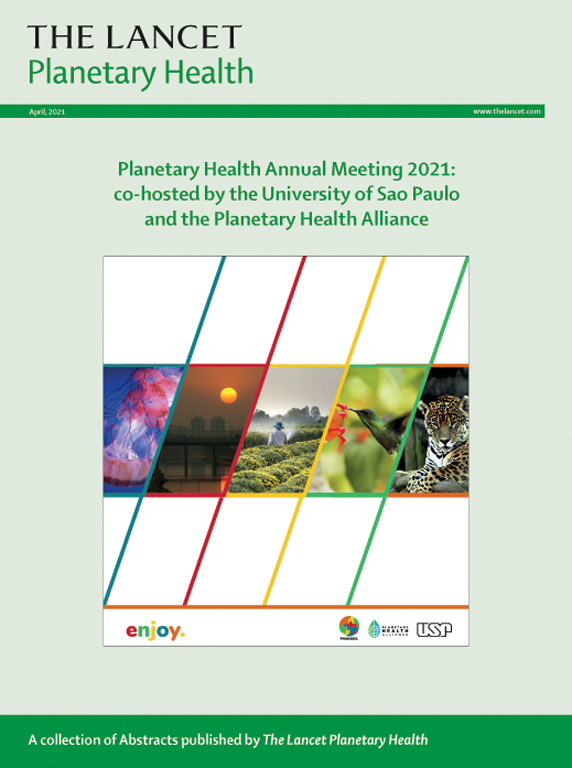建立健康城市设计指数(HUDI):如何促进欧洲城市的健康和可持续性
IF 21.6
1区 医学
Q1 ENVIRONMENTAL SCIENCES
引用次数: 0
摘要
随着全球城市化进程的加速,环境质量的下降和气候挑战的增加,城市规划者和政策制定者将健康和福祉考虑纳入城市规划变得越来越重要。本研究介绍了健康城市设计指数(HUDI),这是一个为欧洲城市开发的高分辨率空间指数。HUDI结合了与城市设计、可持续交通、环境质量和绿色空间可达性相关的政策相关指标,这些指标是影响人类健康和福祉的关键因素。现有的指数通常只关注少数或大城市,缺乏空间粒度,与之不同的是,HUDI提供了高分辨率,并将其范围扩展到中小型城市,这些城市拥有超过50%的欧洲人口。方法基于2018年城市审计数据库,我们分析了917个欧洲城市,916个城市和一个更大的城市。利用开源空间数据,我们绘制了250米网格尺度的城市地图。为了有效地比较城市,我们按照经济合作与发展组织的定义,根据人口规模将它们分为五个城市群:大都市(11个)、大都市(53个)、中型(177个)和小型(638个)城市,以及小城镇(38个)。在城市设计、可持续交通、环境质量和绿色空间可达性四个总体领域中,一组13个指标在250米网格单元尺度上进行了空间计算,然后汇总到城市层面。这13项指标分别是最佳居住密度、紧凑度、中高层发展、渗透率、步行机会、骑行机会、公共交通站点、空气质量(PM2·5和NO2)、周围绿化率(归一化植被指数)、城市低度热岛、绿地通达性和大型绿地通达性。为确保可比性,综合考虑数据质量、指标目标水平和具体评价标准,将所有指标按0 - 10进行标准化。然后通过对这些指标应用不同的权重来计算HUDI,使我们能够在各自的城市规模集群中对城市进行排名。我们使用蜘蛛图可视化了整个城市的表现,并进行了Local Moran's I和Local Indicators of Spatial Association分析,以确定城市规划不佳的地区。我们进行了敏感性测试和相关性分析,并在可用的情况下结合外部数据集来验证我们的发现。研究结果显示,欧洲城市在创造更健康的城市环境方面仍有改进的空间。较大的大都市,尤其是北欧和西班牙部分地区,往往在城市设计和可持续交通领域得分较高。相比之下,中小城市在环境质量方面表现较好。然而,小城市经常在绿色空间可达性方面挣扎,因为步行或骑自行车可以到达的公园和绿色空间很少,尽管周围有很多绿色植物。东西方存在明显的差异,西欧城市,如英国、西班牙和瑞典的城市,获得了最高的HUDI分数,而东欧城市,特别是罗马尼亚、保加利亚和波兰的城市,得分较低。这些发现强调了城市规模和区域因素如何影响城市可持续性和公共卫生成果。HUDI是一个大规模、高分辨率的开放数据工具,可测量近1000个不同规模的欧洲城市的关键城市健康因素。作为一种开源资源,HUDI提供有价值的、数据驱动的见解,帮助城市确定优势、劣势和需要改进的城市管理领域。通过提供明确、可衡量的指标,它帮助决策者和城市规划者查明问题所在,做出明智的决定,以改善公共卫生和可持续性。HUDI是一个动态的工具,而不是一个确定的排名。通过按规模对城市进行分组,可以进行比较、分享知识和最佳实践。需要进一步的研究来完善HUDI,并随着获得更好的数据而扩大其指标和城市。HUDI的一个关键优势是它能够突出数据差距并鼓励更好地收集数据。我们呼吁研究人员和城市规划者通过在GitHub和Zenodo上共享数据和代码来支持HUDI的发展,帮助更有效地跟踪城市健康和可持续性进展。资助项目:西班牙科学与创新部、加泰罗尼亚政府、Investigación生物本文章由计算机程序翻译,如有差异,请以英文原文为准。
Building a Healthy Urban Design Index (HUDI): how to promote health and sustainability in European cities
Background
As global urbanisation accelerates, alongside declining environmental quality and increasing climate challenges, it is increasingly vital for urban planners and policy makers to integrate health and wellbeing considerations into urban planning. This study introduces the Healthy Urban Design Index (HUDI), a high-resolution spatial index developed for European cities. HUDI combines policy-relevant indicators related to urban design, sustainable transportation, environmental quality, and greenspace accessibility—key factors influencing human health and well-being. Unlike existing indices, which often focus on few or large metropolitan cities and lack spatial granularity, HUDI offers high resolution and extends its scope to small-sized and medium-sized cities, home to over 50% of Europe's population.
Methods
We analysed 917 European cities in total, 916 cities and one larger city, on the basis of the 2018 Urban Audit database. Using open-source spatial data, we mapped cities at a fine 250 m grid cell scale. To compare cities effectively, we grouped them into five city clusters on the basis of population size, following the definition of the Organisation for Economic Co-operation and Development: large metropolitan (11), metropolitan (53), medium-sized (177) and small (638) cities, and small towns (38). A set of 13 indicators, across four overarching domains of urban design, sustainable transportation, environmental quality, and green space accessibility was calculated spatially at the 250 m grid cell scale and then aggregated to the city level. The 13 indicators were optimal dwelling density, compactness, mid-rise development, permeability, opportunity to walk, opportunity to cycle, public transport stops, air quality (PM2·5 and NO2), surrounding greenness (Normalized Difference Vegetation Index), lower urban heat islands, universal access to green spaces, and access to large green spaces. To ensure comparability, all indicators were standardised on a scale from 0 to 10, considering data quality, indicator target levels, and specific evaluation criteria. The HUDI was then calculated by applying different weights to these indicators, allowing us to rank cities within their respective city size cluster. We visualised overall city performance using spider plots and did Local Moran's I and Local Indicators of Spatial Association analyses to pinpoint areas with poor urban planning. We did sensitivity tests and correlation analyses, incorporating external datasets where available, to validate our findings.
Findings
HUDI scores ranged from 2·9 to nearly 7 of 10, showing that there is still room for improvement in creating healthier urban environments across European cities. Larger metropolitan cities, particularly in northern Europe and parts of Spain, tended to score well in the urban design and sustainable transportation domains. In contrast, medium and smaller-sized cities did better in the environmental quality domain. However, smaller cities often struggled with the green space accessibility domain, as fewer parks and green spaces were accessible via walking or cycling, despite having plenty of surrounding greenery. A clear east–west divide exists, with cities in Western Europe, such as those in the UK, Spain, and Sweden, achieving the highest HUDI scores, whereas eastern European cities, particularly in Romania, Bulgaria, and Poland, scored lower. These findings highlight how city size and regional factors shape urban sustainability and public health outcomes.
Interpretation
The HUDI is a large-scale, high-resolution, open-data tool that measures key urban health factors across nearly 1000 European cities of different sizes. As an open-source resource, HUDI provides valuable, data-driven insights to help cities identify strengths, weaknesses, and urban management areas needing improvement. By offering clear, measurable indicators, it helps policy makers and urban planners pinpoint problem areas and make informed decisions to improve public health and sustainability. HUDI is a dynamic tool, not a definitive ranking. By clustering cities by size, it enables comparisons, knowledge, and best practice sharing. Further research is needed to refine HUDI and expand its indicators and cities as better data become available. A key strength of HUDI is its ability to highlight data gaps and encourage better data collection. We call on researchers and urban planners to support HUDI development by sharing data and code on GitHub and Zenodo, helping track urban health and sustainability progress more effectively.
Funding
The Spanish Ministry of Science and Innovation, Generalitat de Catalunya, Centro de Investigación Biomédica en red Epidemiología y Salud Pública, Urban Burden of Disease Estimation for Policy Making Horizon Europe project, Barcelona Institute for Global Health, University of Turin, ISI Foundation, and US Department of Energy.
求助全文
通过发布文献求助,成功后即可免费获取论文全文。
去求助
来源期刊

Lancet Planetary Health
Multiple-
CiteScore
28.40
自引率
2.30%
发文量
272
审稿时长
8 weeks
期刊介绍:
The Lancet Planetary Health is a gold Open Access journal dedicated to investigating and addressing the multifaceted determinants of healthy human civilizations and their impact on natural systems. Positioned as a key player in sustainable development, the journal covers a broad, interdisciplinary scope, encompassing areas such as poverty, nutrition, gender equity, water and sanitation, energy, economic growth, industrialization, inequality, urbanization, human consumption and production, climate change, ocean health, land use, peace, and justice.
With a commitment to publishing high-quality research, comment, and correspondence, it aims to be the leading journal for sustainable development in the face of unprecedented dangers and threats.
 求助内容:
求助内容: 应助结果提醒方式:
应助结果提醒方式:


